Filled with temples, tombs and pagodas, Hue is a haven for culture and sight-seeing. Despite the infamously bad weather, the city is picturesque – the Perfume River splits the old city and new city, and all the rain keeps it lush and green.
Given the nightlife nothing to write home about, we had a chance to spend two solid days getting a good feel for the city, and visiting the key sights:
- Imperial Citadel: dates back to 1805 under Gia Long’s (Nguyen Dynasty) rule. It was badly damaged through its history by the many armies, so much if it is just a restoration (and that is ongoing). It is still worth a visit – its a beautiful expansive citadel and even without a guide, makes for a peaceful walk around the grounds.
- Thien Mu Pagoda: a historic Buddhist temple and serves as the official symbol for Hue.
- Khai Dinh tomb: This tomb is fairly new, dating only back to 1925. That said, it is a different style than the others and is compact (just a short climb up steps to get to the tomb). The tomb is extremely ornate, adorned with opulent mosaics along the entire structure, including the traditional dragons done in the small pieces of colorful glass.
- Tu Duc tomb: This is an expansive site, serving not only as a tomb but also as a second Imperial City for the Emperor. While the tomb itself is modest (at least for an emperor), the grounds are impressive. The setting is around a lake, with 30+ wooden pavillions, buildings, temples dedicated to wives, and of course, the tomb.
- American and French bunkers: These bunkers are just next to the Tu Duc tomb, and are located on top of a steep hill overlooking the Perfume River. It is worth wandering up there, even just for the view.
0

















